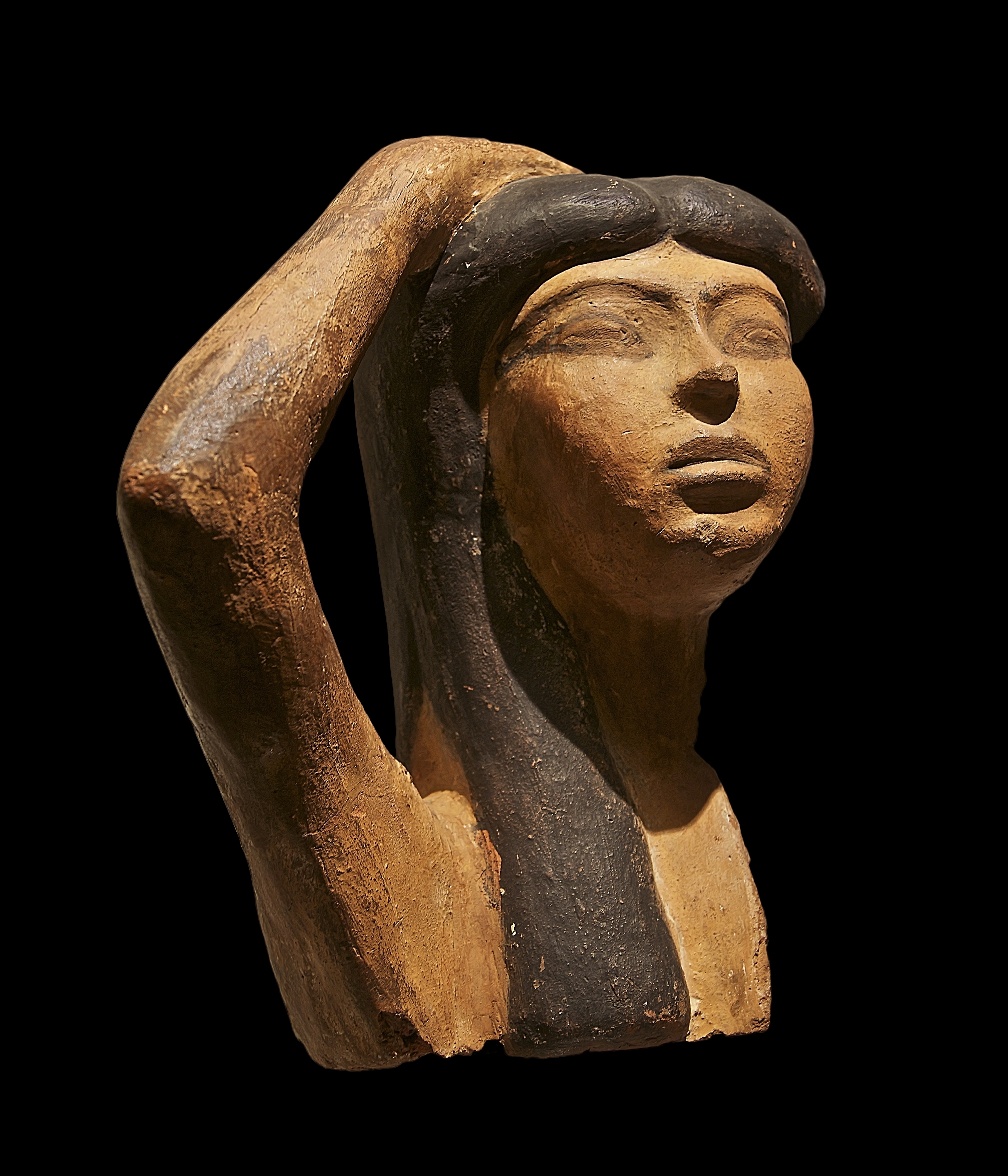|
TT212
The Theban Tomb TT212 is located in Deir el-Medina, part of the Theban Necropolis, on the west bank of the Nile, opposite to Luxor. TT212 is a chapel of the ancient Egyptian scribe in the Place of Truth named Ramose, who lived during the 19th Dynasty. Ramose would have lived in Deir el-Medina during the reign of Ramesses II. TT212 is one of three tombs attributed to Ramose. TT7 and TT250 also belonged to him. This tomb is the smallest of the three. Ramose was the son of Amenemhab and Kakaia. His wife was named Mutemwia. Tomb TT212 only consists of a chapel and a shrine. The chapel contains (damaged) agricultural scenes. The shrine at the back of the chapel shows Ramose making offerings before Harsiese and Thoth. and Ramose and his wife Mutemwia before Osiris and Isis. The back wall contains a hymn to Re while the goddess Nut holds the horizon disk in her arms in mountain. Other gods shown in the scenes include Ptah in a shrine, Maat before Re-Harakhti and a statue of the Ha ... [...More Info...] [...Related Items...] OR: [Wikipedia] [Google] [Baidu] |
Theban Tombs
The Theban Necropolis is located on the west bank of the Nile, opposite Luxor, in Egypt. As well as the more famous royal tombs located in the Valley of the Kings and the Valley of the Queens, there are numerous other tombs, more commonly referred to as Tombs of the Nobles (Luxor), the burial places of some of the powerful courtiers and persons of the ancient city. There are at least 415 cataloged tombs, designated TT for Theban Tomb. There are other tombs whose position has been lost, or for some other reason do not conform to this classification. See for instance the List of MMA Tombs. Theban tombs tended to have clay funerary cones placed over the entrance of the tomb chapels. During the New Kingdom they were inscribed with the title and name of the tomb owner, sometimes with short prayers. Of the 400 recorded sets of cones, only about 80 come from cataloged tombs. The numbering system was first published Arthur Weigall's 1908 ''Report on the Tombs of Shêkh Abd’ el Gûrneh ... [...More Info...] [...Related Items...] OR: [Wikipedia] [Google] [Baidu] |
List Of Theban Tombs
The Theban Necropolis is located on the west bank of the Nile, opposite Luxor, in Egypt. As well as the more famous royal tombs located in the Valley of the Kings and the Valley of the Queens, there are numerous other tombs, more commonly referred to as Tombs of the Nobles (Luxor), the burial places of some of the powerful courtiers and persons of the ancient city. There are at least 415 cataloged tombs, designated TT for Theban Tomb. There are other tombs whose position has been lost, or for some other reason do not conform to this classification. See for instance the List of MMA Tombs. Theban tombs tended to have clay funerary cones placed over the entrance of the tomb chapels. During the New Kingdom they were inscribed with the title and name of the tomb owner, sometimes with short prayers. Of the 400 recorded sets of cones, only about 80 come from cataloged tombs. The numbering system was first published Arthur Weigall's 1908 ''Report on the Tombs of Shêkh Abd’ el Gûr ... [...More Info...] [...Related Items...] OR: [Wikipedia] [Google] [Baidu] |
Osiris
Osiris (, from Egyptian ''wsjr'', cop, ⲟⲩⲥⲓⲣⲉ , ; Phoenician: 𐤀𐤎𐤓, romanized: ʾsr) is the god of fertility, agriculture, the afterlife, the dead, resurrection, life, and vegetation in ancient Egyptian religion. He was classically depicted as a green-skinned deity with a pharaoh's beard, partially mummy-wrapped at the legs, wearing a distinctive atef crown, and holding a symbolic crook and flail. He was one of the first to be associated with the mummy wrap. When his brother, Set cut him up into pieces after killing him, Osiris' wife Isis found all the pieces and wrapped his body up, enabling him to return to life. Osiris was widely worshipped until the decline of ancient Egyptian religion during the rise of Christianity in the Roman Empire. Osiris was at times considered the eldest son of the earth god Geb and the sky goddess Nut, as well as being brother and husband of Isis, and brother of Set, Nephthys, and Horus the Elder, with Horus ... [...More Info...] [...Related Items...] OR: [Wikipedia] [Google] [Baidu] |
Hathor
Hathor ( egy, ḥwt-ḥr, lit=House of Horus, grc, Ἁθώρ , cop, ϩⲁⲑⲱⲣ, Meroitic: ) was a major goddess in ancient Egyptian religion who played a wide variety of roles. As a sky deity, she was the mother or consort of the sky god Horus and the sun god Ra, both of whom were connected with kingship, and thus she was the symbolic mother of their earthly representatives, the pharaohs. She was one of several goddesses who acted as the Eye of Ra, Ra's feminine counterpart, and in this form she had a vengeful aspect that protected him from his enemies. Her beneficent side represented music, dance, joy, love, sexuality, and maternal care, and she acted as the consort of several male deities and the mother of their sons. These two aspects of the goddess exemplified the Egyptian conception of femininity. Hathor crossed boundaries between worlds, helping deceased souls in the transition to the afterlife. Hathor was often depicted as a cow, symbolizing her maternal ... [...More Info...] [...Related Items...] OR: [Wikipedia] [Google] [Baidu] |
Re-Harakhti
Ra (; egy, rꜥ; also transliterated ; cuneiform: ''ri-a'' or ''ri-ia''; Phoenician: 𐤓𐤏,CIS I 3778 romanized: rʿ) or Re (; cop, ⲣⲏ, translit=Rē) was the ancient Egyptian deity of the sun. By the Fifth Dynasty, in the 25th and 24th centuries BC, he had become one of the most important gods in ancient Egyptian religion, identified primarily with the noon-day sun. Ra ruled in all parts of the created world: the sky, the earth, and the underworld. He was the god of the sun, order, kings and the sky. Ra was portrayed as a falcon and shared characteristics with the sky-god Horus. At times the two deities were merged as Ra-Horakhty, "''Ra, who is Horus of the Two Horizons''". In the New Kingdom, when the god Amun rose to prominence he was fused with Ra as Amun-Ra. The cult of the Mnevis bull, an embodiment of Ra, had its center in Heliopolis and there was a formal burial ground for the sacrificed bulls north of the city. All forms of life were believe ... [...More Info...] [...Related Items...] OR: [Wikipedia] [Google] [Baidu] |
Maat
Maat or Maʽat ( Egyptian: mꜣꜥt /ˈmuʀʕat/, Coptic: ⲙⲉⲓ) refers to the ancient Egyptian concepts of truth, balance, order, harmony, law, morality, and justice. Ma'at was also the goddess who personified these concepts, and regulated the stars, seasons, and the actions of mortals and the deities who had brought order from chaos at the moment of creation. Her ideological opposite was Isfet (Egyptian '' jzft''), meaning injustice, chaos, violence or to do evil. Pronunciation Cuneiform texts indicate that the word ''m3ˤt'' was pronounced /múʔʕa/ during the New Kingdom of Egypt, having lost the feminine ending ''t''. Vowel assimilation of ''u'' to ''e'' later produced the Coptic word "truth, justice". History The earliest surviving records indicating that Maat is the norm for nature and society, in this world and the next, were recorded during the Old Kingdom of Egypt, the earliest substantial surviving examples being found in the Pyramid Texts of Unas ... [...More Info...] [...Related Items...] OR: [Wikipedia] [Google] [Baidu] |
Ptah
Ptah ( egy, ptḥ, reconstructed ; grc, Φθά; cop, ⲡⲧⲁϩ; Phoenician: 𐤐𐤕𐤇, romanized: ptḥ) is an ancient Egyptian deity, a creator god and patron deity of craftsmen and architects. In the triad of Memphis, he is the husband of Sekhmet and the father of Nefertem. He was also regarded as the father of the sage Imhotep. Origin and symbolism Ptah is an Egyptian creator god who conceived the world and brought it into being through the creative power of speech. A hymn to Ptah dating to the Twenty-second Dynasty of Egypt says Ptah "crafted the world in the design of his heart," and the Shabaka Stone, from the Twenty-Fifth Dynasty, says Ptah "gave life to all the gods and their '' ka''s as well, through this heart and this tongue." He bears many epithets that describe his role in ancient Egyptian religion and its importance in society at the time: * ''Ptah the begetter of the first beginning'' * ''Ptah lord of truth'' * ''Ptah lord of eternity'' * '' ... [...More Info...] [...Related Items...] OR: [Wikipedia] [Google] [Baidu] |
Nut (goddess)
Nut ( egy, Nwt, cop, Ⲛⲉ), also known by various other transcriptions, is the goddess of the sky, stars, cosmos, mothers, astronomy, and the universe in the ancient Egyptian religion. She was seen as a star-covered nude woman arching over the Earth, or as a cow. She was depicted wearing the water-pot sign (nw) that identifies her. Names The pronunciation of ancient Egyptian is uncertain because vowels were long omitted from its writing, although her name often includes the unpronounced determinative hieroglyph for " sky". Her name ', itself also meaning "Sky", is usually transcribed as "Nut" but also sometimes appears in older sources as Nunut, Nent, and Nuit.Budge, ''An Egyptian hieroglyphic dictionary'' (1920)p. 350 She also appears in the hieroglyphic record by a number of epithets, not all of which are understood. Goddess of the sky Nut is a daughter of Shu and Tefnut. Her brother and husband is Geb. She had four childrenOsiris, Set, Isis, and Nephthysto ... [...More Info...] [...Related Items...] OR: [Wikipedia] [Google] [Baidu] |
Isis
Isis (; ''Ēse''; ; Meroitic language, Meroitic: ''Wos''[''a''] or ''Wusa''; Phoenician language, Phoenician: 𐤀𐤎, romanized: ʾs) was a major ancient Egyptian deities, goddess in ancient Egyptian religion whose worship spread throughout the Greco-Roman world. Isis was first mentioned in the Old Kingdom () as one of the main characters of the Osiris myth, in which she resurrects her slain brother and husband, the divine king Osiris, and produces and protects his heir, Horus. She was believed to help the dead enter the ancient Egyptian afterlife beliefs, afterlife as she had helped Osiris, and she was considered the divine mother of the pharaoh, who was likened to Horus. Her maternal aid was invoked in healing Spell (paranormal), spells to benefit ordinary people. Originally, she played a limited role in royal rituals and Egyptian temple, temple rites, although she was more prominent in ancient Egyptian burial customs, funerary practices and magical texts. She was usually ... [...More Info...] [...Related Items...] OR: [Wikipedia] [Google] [Baidu] |
Deir El-Medina
Deir el-Medina ( arz, دير المدينة), or Dayr al-Madīnah, is an ancient Egyptian workmen's village which was home to the artisans who worked on the tombs in the Valley of the Kings during the 18th to 20th Dynasties of the New Kingdom of Egypt (ca. 1550–1080 BCE)Oakes, p. 110 The settlement's ancient name was '' Set maat'' ("Place of Truth"), and the workmen who lived there were called "Servants in the Place of Truth". During the Christian era, the temple of Hathor was converted into a church from which the Egyptian Arabic name ''Deir el-Medina'' ("Monastery of the City") is derived. At the time when the world's press was concentrating on Howard Carter's discovery of the Tomb of Tutankhamun in 1922, a team led by Bernard Bruyère began to excavate the site."Pharaoh’s Workers: How the Israelites Lived in Egypt", Leonard and Barbara Lesko, Biblical Archaeological Review, Jan/Feb 1999 This work has resulted in one of the most thoroughly documented accounts of com ... [...More Info...] [...Related Items...] OR: [Wikipedia] [Google] [Baidu] |
Thebes, Egypt
, image = Decorated pillars of the temple at Karnac, Thebes, Egypt. Co Wellcome V0049316.jpg , alt = , caption = Pillars of the Great Hypostyle Hall, in '' The Holy Land, Syria, Idumea, Arabia, Egypt, and Nubia'' , map_type = Egypt , map_alt = , map_size = , relief = yes , coordinates = , location = Luxor, Luxor Governorate, Egypt , region = Upper Egypt , type = Settlement , part_of = , length = , width = , area = , height = , builder = , material = , built = , abandoned = , epochs = , cultures = , dependency_of = , occupants = , event = , excavations = , archaeologists = , condition = , ownership = , management = , public_access = , website = , notes = , designation1 = WHS , designation1_offname = Ancient ... [...More Info...] [...Related Items...] OR: [Wikipedia] [Google] [Baidu] |
.jpg)



.jpg)




